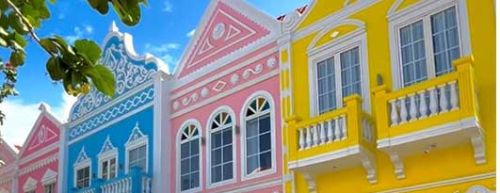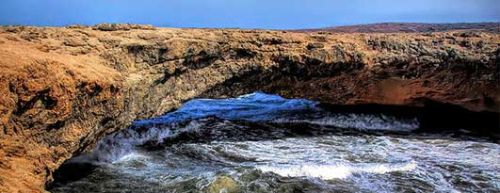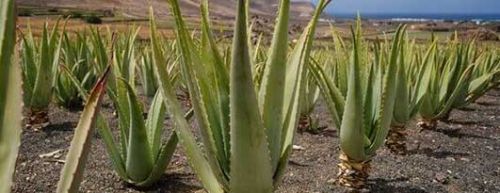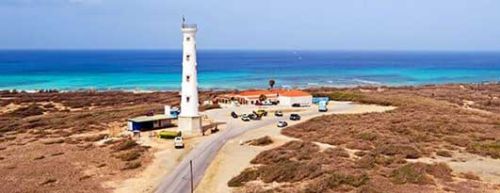Aruba is famous for its windsurfing, snorkeling, scuba diving, sailing, deep-sea fishing, water skiing or just a lazy swim.
Its beaches consist of white sand with calm and incredibly blue waters filled with neon-yellow fish, flame-bright coral reefs and billowing rainbow-colored sails. They are considered to be some of the best beaches in the world.
Aruba has an array of interesting spots to visit including: The Alto Vista Chapel, The Arikok National Park, The Ayo & Casibari Rock Formations, The Bushiribana & Balashi, The California Lighthouse, The Frenchman's Pass, The Hooiberg, The Lourdes Grotto, Caves and the Aruba Aloe Factory.

The capital, located on the south coast on the west side of the island, is extremely picturesque with its Dutch colonial architecture in pastel colors. Along the quay, merchants come every morning to sell fresh fish and produce from the boat. You can go here to score nice souvenirs, but also to eat delicious food! Take a look at the Renaissance Marketplace. In the evening, live music plays here while you are having a nice dinner or a drink.

Is Aruba's ecological treasure. Among the desert vegetation in the park, are divi-divi trees, rare exotic cacti, aloe plants, and colorful tropical flowers. The park is open daily from 8 a.m. to 4 p.m. Follow the signs to "Parke Nacional Arikok" from the city of Santa Cruz to the park entrance on the left a short distance past the paved road.
Want to visit this park under the siege of a tour? You can! Together with The Palm Tours this is possible, for more information send us an email (rentals@arubahappyrentals.com) or call us at +297 586 2662.

Is one of Aruba's most popular attractions, still after collapse in 2005. The bridge is a formation of coral limestone cut out by years of pounding surf, and is one of the largest of these types of spans in the world. It stands some 23 feet (7 meters) above sea level and spans more than 100 feet (30 meters).

This small rock-enclosed seawater pool is difficult to enter and exit, and not worth the trouble, unless you just want to cool off. However, it is worthwhile to climb up onto boulder to watch the ocean surf break over the rocks and cascade into the basin. Forget about snorkeling, the water is too churned up. Visit the pool for the magnificent views.

A unique Caribbean energy is present in Aruba's second largest city, San Nicolas, with a majority of residents originally from the British Caribbean. The town's development is undeniably linked to the oil refinery, whose presence is often in stark contrast to the area's modest homes and picturesque beach spots.
For years, one of the main reasons visitors found their way to this part of the island was to stop by Charlie's Bar. This bar has been famous since the 1940s, when divers began hanging their underwater finds on the walls there. Since then, it has become a museum of sorts. Be sure to go here for a drink!
San Nicolas is only now beginning to develop into an "alternative" tourist destination. Hotels are being built or renovated that reflect the town's history when sailors from around the world went on leave to enjoy local hospitality.
Enjoy all the beautiful murals present in the town. New murals are added every year by local artists.

Known for its peaceful swimming cave, it is located in Seroe Colorado on the southeast side of the island, near the oil refinery. It really is a must visit here after visiting San Nicolas. Here you can unwind and is perfect for children because the water here is quite low.

Gold was found in Aruba in 1824, presumably by a boy playing in a dry creek bed, and for several years local residents were allowed to collect and sell the precious metal at a price set by the government. Thirty years later, the Aruba Island Gold Mining Company obtained all rights to the cache and built the large smelter at Bushiribana. Today you can climb around the fallen pile of rocks where the mall was once located.
It's also a great photo spot and can be reached by car!

The Guadirikiri Cave is famous for its two chambers, illuminated by the sunlight streaming through holes in the roof of the cave.The cave extends for about 100 feet. In the darker portions of the cave nest hundreds of harmless bats.
The Fontein Cave is the most popular of the caves as it is the only one that has the drawings of Arawak Indians on the ceilings, providing a real sense of island history to this cave. The Tunnel of Love because of the heart shaped opening at its entrance.
Want to visit the caves and Arikok National Park under the siege of a tour? You can! Together with The Palm Tours this is possible, for more information send us an email (rentals@arubahappyrentals.com) or call us at +297 586 2662.

Take a tour through the state-of-the-art Aruba Aloe Factory and see the production process firsthand from aloe vera leaf to finished Aruba Aloe lotions! The tour guides will explain you all about the aloe plant and its uses and you will have the opportunity to learn all about the 160-year old aloe history of Aruba in the museum which is a national depository for ancient aloe tools and equipment with a complete library on the history, manufacture and qualities of aloe vera.

Is aptly located in the center of town in Fort Zoutman, Aruba’s oldest building dating back to 1798. The museum hosts the Bonbini Festival, a folkloric event that takes place every Tuesday evening at 6:30 pm.

Casibari Boulders Clusters of huge tonalite boulders lie together in an area just north of Haystack. This rock formation, unique from the more typical features of the area, rises inexplicably from the desert soil to form an unusual environment. Some of the rocks weigh several tons and have peculiar shapes. The government of Aruba has built hiking trails and stairs through the boulders, so hikers can reach the top for breathtaking views of the island.
Ayo Rock Formations Towering stone boulders, placed so close together and in unusual designs, combined with the peaceful setting of Ayo, create a sense of awe and an understanding of why the area was once considered a sacred place by the island's original inhabitants. Rock drawings thousands of years old have been found at this site, where huge stones appear to have been scattered like marbles by an errant giant. Modern trails have been constructed to help visitors better explore this ancient site.
Tip: go here during sunrise or sunset to get the best photos! You overlook The Haystack; you can also climb it first for an even more beautiful view of the entire island.

Was named after a ship called the "California." It was a wooden ship sailing from England to Venezuela when it ran aground off the northwest corner of Aruba on Sept. 23, 1891. The California lighthouse was completed in 1914. Located on a high seawall, the lighthouse has become one of Aruba's picturesque trademarks and offers a perfect view of the island's western coastline of sandy beaches. Around the lighthouse are acres of flat land full of rocks, and an area called California White Sand Dunes is very popular with children who go dune surfing.
For a small fee, you can climb the lighthouse and enjoy an impressive view of Aruba!